Abstract
Agricultural development is one of the most powerful tools to end extreme poverty but agriculture-driven growth, poverty reduction, and food security are at risk. Plant diseases and insect pests are major limiting factors that reduce crop production worldwide. Fall armyworm (Spodoptera frugiperda) is a serious pest of agricultural crops and the use of silicon (Si) has shown promise in various crops due to its capability of changing plant defenses. Present investigations were carried out for the management of FAW on maize and its effects on the biology of fall armyworm under laboratory conditions. In field trials, silicon dioxide (SiO2) was evaluated at three concentrations, i.e., 400, 800, and 1200 ppm, against maize FAW. Foliar and drenching applications of silicon dioxide at the maximum concentration (1200 ppm) exhibited significant results, with the minimum FAW population following 800 and 400 ppm, respectively. In the 2nd complement of the research, the biological parameters of fall armyworm were assessed under in vitro conditions by feeding larvae with silicon-treated leaves. Results revealed that the larvae survival rate was minimum (36%) at maximum silicon application in comparison to the control (95%). The pupal duration was increased to 13.66 days, compared to the control with 7.66 days. Moreover, the adult longevity was also reduced to 7.67 days and fecundity was reduced to 254 eggs, in comparison to the control with 512 eggs. Silicon had a significant effect on the biology of fall armyworm and its application can be a potential management technique for fall armyworm.
1. Introduction
The armyworm, Spodoptera frugiperda (Lepidoptera: Noctuidae)], is an exceedingly polyphagous, migratory pest that is native to the Americas and has also been observed in Africa [1] and Asia ([2]). Moreover, it is also a significant commercial maize pest in South and Central America [3]. The pest can spread quickly over large areas in a short time [4]. S. frugiperda has gained international attention and now poses a serious threat to the nutrition, food security, and way of life of hundreds of millions of agrarian households in Africa and Asia, particularly in maize-dependent areas [5].
Different tools and techniques for controlling S. frugiperda have been created. Novel synthetic insecticides are still thought to be one of the most effective treatments in Asia for S. frugiperda [6,7]. Scientists are working to create biopesticides that incorporate entomopathogenic fungus [8], plant-based insecticides [9], and other ingredients that are less hazardous to humans, the environment, and natural predators. S. frugiperda cannot be managed over the long run using a single strategy.
Silicon has the ability to increase a plant’s resistance to insect herbivores of the orders Homoptera, Lepidoptera [10], Diptera [11], Hemiptera [12], Coleoptera, and Thysanoptera [13], without having any adverse effects on the effectiveness of the plant’s natural enemies. A fully fledged defense response could be triggered when an abiotic danger is recognized, since silicon may make it harder for insects to dampen a plant’s defenses [14]. Additionally, a plant species’ capacity to take in and move silicon throughout its tissues varies substantially. Thus, it is advisable to use exogenous silicon treatments at regular intervals to prevent plants from herbivorous feeding [15]. Therefore, present investigations were carried out in light of the aforementioned information to investigate the effects of silicon application at different concentrations against a S. frugiperda population under field conditions and to determine their impact on S. frugiperda biology under controlled conditions.
2. Material and Methods
2.1. Experimental Site
The experiment was carried out at the Entomological research area, University of Agriculture Faisalbad, based in Punjab province, Pakistan (31.4278° N, 73.0758° E). The climate featured is a semi-arid climate. During the experiment in the spring growing season, the average temperature was 27.6 °C/81.68 °F, and a relative humidity of 36.25% and 16.25 was recorded [16]. CM-7777 was sown at a defined experimental area using an RCBD layout. The field was divided into 2 blocks for drenching and foliar treatments with different silicon concentrations.
2.2. Silicon Application and Data Collection
Maize plants were treated with Silicon dioxide (SiO2) using drenching or foliar treatment methods, each with a concentration of 400 ppm, 800 ppm and 1200 ppm. Drenching treatments were sprayed directly into the soil, while foliar applications were performed with the use of a sprayer (1 L spray bottle) (Figure 1). Moreover, the water application served as the untreated control. During the process of the analysis, maize plants were exposed to the silicon treatment three times after 15 days of seedling emergence and following a 10-day interval. The fall armyworm population was recorded in the field after silicon exposure at different concentrations on datasheets.
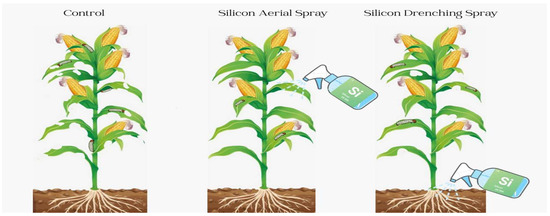
Figure 1.
Schematic illustration of the maize plant for silicon application.
2.3. Insect Culture and Data Collection
Spodoptera frugiperda larvae were obtained from the field and kept in cages to maintain a colony (Figure 2). These larvae were provided with silicon-treated maize leaves. The colony was maintained at a 25 ± 5 °C temperature, a 65 ± 5 relative humidity, and 16:8 (L:D)-hour photoperiod in a growth chamber. The F1 generation was fed until pupation on the silicon-treated maize leaves, and their biological parameters (larval duration, survival, pupal duration, adult longevity, and fecundity) were recorded regularly (Figure 3). For each treatment, counted numbers of specimens were used to assess the effect of silicon on their biology. In the control treatments, silicon-free leaves were offered to larvae on a regular basis.
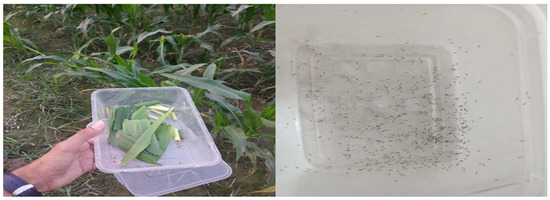
Figure 2.
Collection of the larvae from the FAW-infested field.
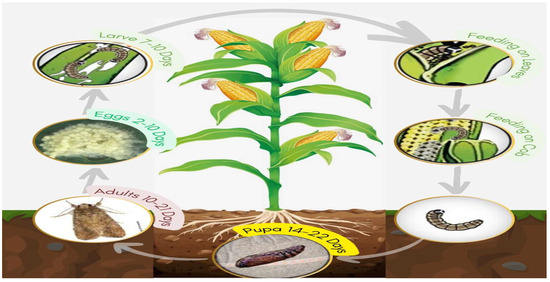
Figure 3.
Schematic illustration of the fall armyworm (FAW) biology.
3. Results and Discussion
3.1. Assessment of Silicon Dioxide on Spodoptera frugiperda Population In Vivo
The application of silicon dioxide at a concentration of (1200 ppm) significantly affected the fall armyworm (FAW) population (0.9, 0.7, 0.3), respectively, at all observation points in comparison to the control. However, the same concentration also produced significant results (0.9, 0.8, 0.6%) during the soil-drenching application. Among all concentrations, the application of silicon dioxide at the minimum rate (400 ppm) exhibited the minimum FAW population reduction at all observation (2.24, 1.75, 0.85%) points during foliar application, and during soil drench it showed (1.6, 1.5, 1.85%) a population reduction at all observation points in comparison to the control (Figure 4).
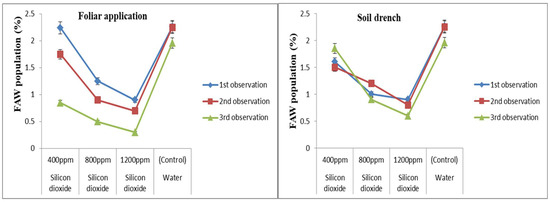
Figure 4.
Impact of the foliar and soil drench application of silicon dioxide at different concentrations against the fall armyworm (FAW) population in in vivo conditions.
3.2. Assessment of Silicon Dioxide on Spodoptera frugiperda Biology In Vitro
The results revealed that the application of silicon dioxide significantly influenced the Spodoptera frugiperda biology at different concentrations. The maximum application of silicon dioxide increased the larval duration (22.3%) and pupal duration (11.5) and decreased the larval survival (36.66%), adult longevity (7.61) and fecundity rate (191). Among all concentrations of silicon dioxide, a minimum increase in larval duration and pupal duration and a decrease in larval survival and adult longevity were recorded at 400 ppm (Figure 5).
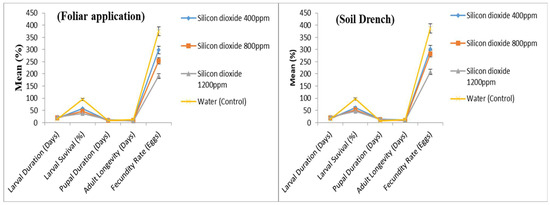
Figure 5.
Impact of the foliar and soil drench application of silicon dioxide at different concentrations against the biology of fall armyworm (FAW) in vitro conditions.
Silicon is described as a booster that has been used to counteract several abiotic and biotic stresses [17]. The results of the contemporary study were same as recorded by [18], which showed that the foliar spray of SiO2 caused the highest larval mortality and decreased the fall armyworm infestation on maize plants. Results of the present study are in line with the findings of [19] that the foliar spraying of silicon was more effective in reducing the population density of B. tabaci and T. absoluta in tomato crop compared to a Si-soil drench application. Results are also supported by the work of [20], which concluded that Si addition improves the leaf silicon concentration in all parts of plants and decreases fall armyworm infestation. Results are also in the agreement with the work of [21], finding that SiO2 significantly decreased oviposition and prolonged the length of all immature stages as well as the overall cycle.
Author Contributions
Conceptualization, M.S.; methodology, M.S.; software, M.A.G.; validation, M.S.; formal analysis, M.A.G.; investigation, M.S.; resources, M.A.G.; data curation, M.A.G.; writing—original draft preparation, M.A.G.; writing—review and editing, L.W.; visualization, L.W.; supervision, M.S. and L.W.; project administration, M.S.; funding acquisition, M.S. All authors have read and agreed to the published version of the manuscript.
Funding
This research received no external funding.
Institutional Review Board Statement
Not applicable.
Informed Consent Statement
Not applicable.
Data Availability Statement
Data are contained within the article.
Conflicts of Interest
The authors declare no conflict of interest.
References
- Goergen, G.; Kumar, P.L.; Sankung, S.B.; Togola, A.; Tamò, M. First report of outbreaks of the fall armyworm Spodoptera frugiperda (JE Smith) (Lepidoptera, Noctuidae), a new alien invasive pest in West and Central Africa. PloS ONE 2016, 11, e0165632. [Google Scholar] [CrossRef]
- Kalleshwaraswamy, C.; Maruthi, M.; Pavithra, H. Biology of invasive fall army worm Spodoptera frugiperda (JE Smith) (Lepidoptera: Noctuidae) on maize. Indian J. Entomol. 2018, 80, 540–543. [Google Scholar]
- Nagoshi, R.N.; Rosas-García, N.M.; Meagher, R.L.; Fleischer, S.J.; Westbrook, J.K.; Sappington, T.W.; Hay-Roe, M.; Thomas, J.M.; Murúa, G.M. Haplotype profile comparisons between Spodoptera frugiperda (Lepidoptera: Noctuidae) populations from Mexico with those from Puerto Rico, South America, and the United States and their implications to migratory behavior. J. Econ. Entomol. 2015, 108, 135–144. [Google Scholar] [CrossRef] [PubMed]
- Van den Berg, J.; Prasanna, B.M.; Midega, C.A.; Ronald, P.C.; Carrière, Y.; Tabashnik, B.E. Managing fall armyworm in Africa: Can Bt maize sustainably improve control? J. Econ. Entomol. 2021, 114, 1934–1949. [Google Scholar] [CrossRef] [PubMed]
- FAO; IFAD; UNICEF; WFP; WHO. The State of Food Security and Nutrition in the World 2020: Transforming Food Systems for Affordable Healthy Diets; Food & Agriculture Org.: Rome, Italy, 2020. [Google Scholar]
- Liu, Z.-K.; Li, X.-L.; Tan, X.-F.; Yang, M.-F.; Idrees, A.; Liu, J.-F.; Song, S.-J.; Shen, J. Sublethal effects of emamectin benzoate on fall armyworm, Spodoptera frugiperda (Lepidoptera: Noctuidae). Agriculture 2022, 12, 959. [Google Scholar] [CrossRef]
- Nisar, M.S.; Ali, S.; Hussain, T.; Ramzan, H.; Niaz, Y.; Haq, I.U.; Akhtar, F.; Alwahibi, M.S.; Elshikh, M.S.; Kalaji, H.M. Toxic and repellent impacts of botanical oils against Callosobruchus maculatus (Bruchidae: Coleoptera) in stored cowpea [Vigna unguiculata (L.) Walp.]. PLoS ONE 2022, 17, e0267987. [Google Scholar] [CrossRef] [PubMed]
- Idrees, A.; Afzal, A.; Qadir, Z.A.; Li, J. Bioassays of Beauveria bassiana isolates against the fall armyworm, Spodoptera frugiperda. J. Fungi 2022, 8, 717. [Google Scholar] [CrossRef] [PubMed]
- Ahmed, K.S.; Idrees, A.; Majeed, M.Z.; Majeed, M.I.; Shehzad, M.Z.; Ullah, M.I.; Afzal, A.; Li, J. Synergized toxicity of promising plant extracts and synthetic chemicals against fall armyworm Spodoptera frugiperda (JE Smith) (Lepidoptera: Noctuidae) in Pakistan. Agronomy 2022, 12, 1289. [Google Scholar] [CrossRef]
- Haq, I.U.; Khurshid, A.; Inayat, R.; Zhang, K.; Liu, C.; Ali, S.; Zuan, A.T.K.; Al-Hashimi, A.; Abbasi, A.M. Silicon-based induced resistance in maize against fall armyworm [Spodoptera frugiperda (Lepidoptera: Noctuidae)]. PLoS ONE 2021, 16, e0259749. [Google Scholar] [CrossRef]
- Parrella, M.P.; Costamagna, T.P.; Kaspi, R. The addition of potassium silicate to the fertilizer mix to suppress Liriomyza leafminers attacking chrysanthemums. In Proceedings of the VIII International Symposium on Protected Cultivation in Mild Winter Climates: Advances in Soil and Soilless Cultivation under Protected Environment, Agadir, Morocco, 19 February 2006; pp. 365–370. [Google Scholar]
- Dias, P.; Sampaio, M.; Rodrigues, M.; Korndörfer, A.; Oliveira, R.; Ferreira, S.; Korndörfer, G. Induction of resistance by silicon in wheat plants to alate and apterous morphs of Sitobion avenae (Hemiptera: Aphididae). Environ. Entomol. 2014, 43, 949–956. [Google Scholar] [CrossRef] [PubMed]
- Moraes, J.C.; Ferreira, R.S.; Costa, R.R. Resistance inducers to the whitefly Bemisia tabaci Biotype B (GENN., 1889) (Hemiptera: Aleyrodidae) in soybeans. Cienc. Agrotecnologia 2009, 33, 1260–1264. [Google Scholar] [CrossRef]
- Vivancos, J.; Labbé, C.; Menzies, J.G.; Bélanger, R.R. Siliconmediated resistance of A rabidopsis against powdery mildew involves mechanisms other than the salicylic acid (SA)-dependent defence pathway. Mol. Plant Pathol. 2015, 16, 572–582. [Google Scholar] [CrossRef] [PubMed]
- Badshah, S.L.; Faisal, S.; Muhammad, A.; Poulson, B.G.; Emwas, A.H.; Jaremko, M. Antiviral activities of flavonoids. Biomed. Pharmacother. 2021, 140, 111596. [Google Scholar] [CrossRef] [PubMed]
- Shen, B.-W.; Pielke Sr, R.; Zeng, X.; Cui, J.; Faghih-Naini, S.; Paxson, W.; Kesarkar, A.; Zeng, X.; Atlas, R. The dual nature of chaos and order in the atmosphere. Atmosphere 2022, 13, 1892. [Google Scholar] [CrossRef]
- Liang, Y.; Nikolic, M.; Bélanger, R.; Gong, H.; Song, A. Silicon-mediated tolerance to salt stress. In Silicon in Agriculture; Springer: Dordrecht, The Netherlands, 2015; pp. 123–142. [Google Scholar]
- Haq, I.U.; Zhang, K.; Ali, S.; Majid, M.; Ashraf, H.J.; Khurshid, A.; Inayat, R.; Li, C.; Gou, Y.; Al-Ghamdi, A.A. Effectiveness of silicon on immature stages of the fall armyworm [Spodoptera frugiperda (JE Smith)]. J. King Saud Univ. Sci. 2022, 34, 102152. [Google Scholar] [CrossRef]
- Alyousuf, A.; Hamid, D.; Desher, M.A.; Nikpay, A.; Laane, H.-M. Effect of silicic acid formulation (Silicon 0.8%) on two major insect pests of tomato under greenhouse conditions. Silicon 2022, 14, 3019–3025. [Google Scholar] [CrossRef]
- Acevedo, F.E.; Peiffer, M.; Ray, S.; Tan, C.-W.; Felton, G.W. Silicon-mediated enhancement of herbivore resistance in agricultural crops. Front. Plant Sci. 2021, 12, 631824. [Google Scholar] [CrossRef] [PubMed]
- Abbasi, A.; Sufyan, M.; Arif, M.J.; Sahi, S.T. Effect of silicon on oviposition preference and biology of Bemisia tabaci (Gennadius) (Homoptera: Aleyrodidae) feeding on Gossypium hirsutum (Linnaeus). Int. J. Pest Manag. 2022, 68, 124–134. [Google Scholar] [CrossRef]
Disclaimer/Publisher’s Note: The statements, opinions and data contained in all publications are solely those of the individual author(s) and contributor(s) and not of MDPI and/or the editor(s). MDPI and/or the editor(s) disclaim responsibility for any injury to people or property resulting from any ideas, methods, instructions or products referred to in the content. |
© 2023 by the authors. Licensee MDPI, Basel, Switzerland. This article is an open access article distributed under the terms and conditions of the Creative Commons Attribution (CC BY) license (https://creativecommons.org/licenses/by/4.0/).